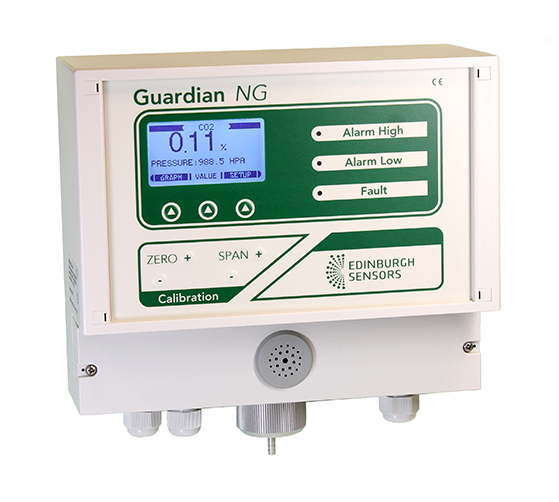Monitoring air quality is both an essential part of health and safety and for ensuring a pleasant workplace environment. For example, in breweries or dry food storage areas, where carbon dioxide is produced as part of the fermentation process, monitoring gas levels is key for protecting workers’ health.1 Even in office buildings, where chemical processing may not be a risk, monitoring the chemical composition of the air can help avoid ‘sick building syndrome’ and maximize employee comfort.2
Air sampling techniques are used to monitor air composition as a function of time but there are a range of different approaches that can be used to perform air sampling. Each approach has advantages and disadvantages and the best approach is dependent on a combination of available resources, the necessary application and the potential health risks posed by the workplace. For example, for workplaces were high levels of asphyxiant or toxic gases are a risk, constant, online monitoring of air composition may be a legal health and safety requirement.3 In this article we explore air sampling techniques and the role played by Edinburgh Sensors.
Grab Sampling as an Air Sampling Technique
Grab sampling is where a sample of air is taken at a specific time and analysed. Often, the sample is removed from the environment and taken to a different location for testing, if it is not feasible to do the types of composition analysis required in situ.
While grab sampling is convenient and produces relatively small data sets, as the number of samples will just be the number of grabs taken during the day, the ability to perform offline analysis has some advantages.
For air analysis, techniques that are often used for the analysis of grab samples include gas chromatography or hyphenated versions of the technique that include additional gas chromatography or mass spectrometers for more accurate identification of compounds.4 Such analysers provide very high-quality information and excel for complex mixtures.
Passive or Active Air Sampling Techniques
Grab sampling though is very labor-intensive and large numbers of samples may be necessary to accurately characterise a site. One alternative to this is to use continual monitoring where a device is placed in situ and can continually collect samples that can then be analysed later.
Gas monitoring devices for this type of sampling can be classified as either active or passive. Passive sampling technology is any device that monitors gas concentrations by simply allowing the air to pass over it rather than being pumped. The motion of the gas molecules means they will collide with a certain probability with a sorbent where they can then be detected.5
In active sampling, rather than relying on gas diffusion into the device, the gas is pumped into the sorbent medium. Active sampling devices tend to be more bulky and complex due to the need for pumping equipment as well as the detector, however, the measured gas concentrations are less sensitive to environmental influences such as changes in wind speed or humidity.
Using sorbent tubes to collect air samples though does have one key disadvantage, the tubes still need to be removed for later analysis. Ideally, an on-site sampler would also contain a detector which could be connected to a data stream for fully online, automated monitoring.
Edinburgh Sensors
The need for continual data logging 24/7 monitoring of air quality in potentially hazardous areas is why, for air sampling, Edinburgh Sensors offers nondispersive infrared-based detectors (NDIR) for the gas monitoring products.6
NDIR technologies allow for continual online gas analysis all within one small device. Edinburgh Sensors offer several ‘boxed’ units, such as the Guardian NG7 and Boxed Gascard,8 that simply need a connection to a power supply and reference gas and can immediately be used. The Guardian NG series comes with its own on-device display which can show current readings, plot some historical data and has a menu interface for easy change of settings. As it can be used as a stand-alone device, the Guardian NG has a built-in alarm system so that if any gas concentrations exceed a certain range, a built-in alarm can be sounded.
Edinburgh Sensors has NDIR devices suitable for detecting a wide range of gases, including carbon dioxide, carbon monoxide, nitrous oxide, and various refrigerants. The Guardian NG and GasCard9 are the most versatile of the gas monitors offered, capable of detecting the largest variety of gases and both offer excellent sensitivity, accuracy and rapid response times.

For air sampling in challenging environmental conditions, all of Edinburgh Sensor’s devices offer pressure and humidity compensated readout across a humidity range of 0 – 95 %. The Guardian NG boasts a ± 2 % accuracy over its full detection range, which is 0 – 100 % in the case of gases like methane and carbon dioxide. For some air sampling applications, it may be advantageous rather than having static ‘boxed’ devices, designed for installation on walls, to implement the gas monitoring on unmanned aerial vehicles or drones. The Gascard NG is a highly flexible, lightweight sensor with a sufficiently low power draw that it can be incorporated into such applications.
All of Edinburgh Sensors gas monitors can be interfaced with external networked data logging, ideal for true continual air sampling.
View our range of Gas Monitors.
Keep in Touch
If you have enjoyed reading our article on Air Sampling Techniques, why not sign-up to our monthly eNewsletter via the button below and stay up to date with our latest news, products and articles.
Alternatively, if you are working in the field of Air Sampling and would like further information on how our gas sensors can help you with your work, please do not hesitate to contact us. We look forward to hearing from you.
References
- Hatice Pekmez. (2017). Cereal Storage Techniques: A Review. Journal of Agricultural Science and Technology B, 6(2), 1–6. https://doi.org/10.17265/2161-6264/2016.02.001
- WHO on Sick Building Syndrome (2019) https://www.wondermakers.com/Portals/0/docs/Sick%20building%20syndrome%20by%20WHO.pdf
- HSE on Carbon Dioxide, (2019) http://www.hse.gov.uk/carboncapture/carbondioxide.htm
- Lerner, B. M., Gilman, J. B., Aikin, K. C., Atlas, E. L., Goldan, P. D., Graus, M., … De Gouw, J. A. (2017). An improved, automated whole air sampler and gas chromatography mass spectrometry analysis system for volatile organic compounds in the atmosphere. Atmospheric Measurement Techniques, 10(1), 291–313. https://doi.org/10.5194/amt-10-291-2017
- Zabiegała, B., Kot-Wasik, A., Urbanowicz, M., & Namieśnik, J. (2010). Passive sampling as a tool for obtaining reliable analytical information in environmental quality monitoring. Analytical and Bioanalytical Chemistry, 396(1), 273–296. https://doi.org/10.1007/s00216-009-3244-4
- Edinburgh Sensors (2019) https://edinburghsensors.com/about/our-history/
- Guardian NG (2019) https://edinburghsensors.com/products/gas-monitors/guardian-ng/
- Boxed GasCard (2019) https://edinburghsensors.com/products/oem/boxed-gascard/
- Gascard NG, (2019), https://edinburghsensors.com/products/oem/gascard-ng/

